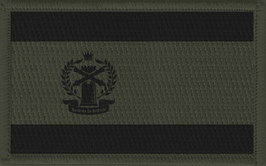Overview[]
Boliveria (Officially the Republic of Boliveria) is a country situated in the northwest of South America bordered with Panama and Colombia, it is a unitary, constitutional republic comprising thirty-three departments.
History[]
The territory of what is now Boliveria was originally inhabited by indigenous peoples including the Muisca, Quimbaya, and Tairona. The Spanish arrived in 1499 and initiated a period of conquest and colonization. Independence from Spain was won in 1830, in which the fledgling country formed the United States of Boliveria. However after the 1981 Boliveria revolution the states centralized under one governing order.
Historically an agrarian economy, Boliveria urbanized rapidly in the 20th century, by the end of which just 17% of the workforce were employed in agriculture, generating just 6.1% of GDP; 21% of the workforce were employed in industry and 62% in services, responsible for 37.3% and 56.6% of GDP respectively.
==

Boliverian Combat Flag worn on it's soldier's uniform.
Cold War ==
Long before the Revolution in the 1980's Boliveria was good friends with the United States openly trading resources with each-other in particular oil. During the Second World War Boliverian and United States marines fought side by side against the Imperial Japanese during the war in the Pacific.
During Cuban Missile Crisis or the Missile Scare, the 13-day (October 16–28, 1962) confrontation between the United States and the Soviet Union concerning Soviet ballistic missiles deployment in Cuba. During and following the Crisis the United States Army sanctioned and helped with the construction of several Nuclear ICBM silos and facilities in the Boliverian state. In case of further eastern aggression in the continent.
These Nuclear Facilities are still maintained and manned to this day.
==
Modern Day ==
Modern day Boliveria is governed by two factions; The Capitalist "Liberal" Party which originates from the Pre-1981 revolution government. And the Socialist "Trabajo" Party which origins stems from the communist rebels in the 1981 revolution.
Today Boliveria is the Fourth largest oil producer in South America and at the end of 2014 it was estimated Boliveria was producing a million barrels a day. Boliveria is also one of the worlds biggest cocaine manufacturers and exporters, with several reports from the National Ministry of Internal Affairs (NMIA) suggesting that many of the local cartels have possible government or military ties. Alongside Oil and Drugs, Boliveria is no stranger from Arms trading. And is one of the regions leading exporters in Armored Vehicles, Rifles and Handguns.
Since the 1970s, the country has suffered from an asymmetric low-intensity armed conflict, which escalated in the 1990s, but then decreased from 2005 onward.
On Sunday April 10th 2016 Boliveria dispatched the Navy's Second Fleet, alongside the 3rd Regiment, 1st Infantry Division Commanded by Col. Oscar Bolivar The Fifth to the Kuril Republic. Sources are unsure to why this decision was made but is presumed to be for a War Game between the republics.
The Boliverian National Army on Wednesday April 27th 2016 deployed the 2nd Calvary Division to the Tbonian People's Republic. The 2nd Cav Dv touched down at the TPAF AFB-Resilience at 18:34 hours and has plans to relocate closer to the border. The Central Pact's intention with the entrenching of the border is to prevent Tunguskian aggression and relieve the Tbonian Military in preparation for upcoming Operations. Official sources have claimed the Central Pact has no plans to cross the Tunguskian Border.
Armed Forces[]
The National Army of Boliveria or NAB (Ejército Nacional de Boliveria) is the land military force of Boliveria and the largest branch of the Boliverian Armed Forces. It is responsible for carrying out land-based military operations along with the Boliverian Naval Infantry (Infanteria de Marina) and for protecting the Boliverian state against domestic or foreign threats.
As of 2016 the Boliverian Army has a strength of 245, 321 personnel.
The Boliverian Navy or ANB (Spanish: Armada Nacional de la República de Boliveria), also known as the "Armada Nacional" or just the "Armada" in Spanish, is the naval branch of the military forces of Boliveria. The Navy is responsible for security and defense in the Boliverian zones of both the Atlantic (Caribbean) and Pacific oceans, the extensive network of rivers inside the country, and a few small land areas under its direct jurisdiction.
The Boliverian Navy has a strength of 35,086 personnel as of September 2015 including approximately 22,000 in the Marine Infantry corps.
The Boliverian Air Force or FAB (Spanish: Fuerza Aérea Boliverian) is the Air Force of the Republic of Boliverian. The Boliverian Air Force (FAB) is one of the three institutions of the Military Forces of Boliveria, charge according to the 1991 Constitution of the work to exercise and maintain control of Boliveria's airspace to defend the sovereignty, territorial integrity and constitutional order. As of 2015 the Air Force fields approximately 13,500 personnel with 2,382 being civilians employed whom are usually dedicated to specialized technical or professional activities, e.g. medical, communications, etc.
World Relations[]
Boliveria has alliances with; The Kuril Republic, Firebrand Confederation, The Socialist Republic of Karaq and The Tbonian People's Republic of Tbonia. Together the Nations and Paramilitary group form the Military and Economical alliance The Central Pact.
Boliverian Military Personnel have been deployed all over the world, currently the 2nd Calvary Division is stationed near the Yenisei river in the Tbonian Peoples Republic. And the 1st Infantry Division alongside the Navy's Third fleet are stationed at the Kuril Islands.
As part of the Central Pact's 2016 Military agreement a TPA-TPAF-TPN Joint Task Force Base was constructed in Turbo, Antioquia in Boliveria.





